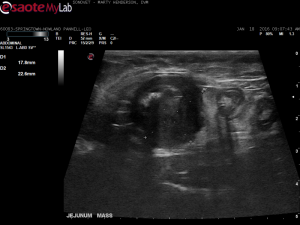Sonographic Differential Diagnosis
1. Intestinal Mass - the findings are moderately-severe - DDx: adenocarcinoma vs. infiltrative neoplasia (lymphosarcoma vs. mast cell tumor) vs. feline gastrointestinal eosinophilic sclerosing fibroplasia (FGESF) vs. leiomyosarcoma vs. leiomyoma, dry form FIP possible but less likely. 2. Lymph nodes - the findings are suggestive of metastasis from the intestinal mass - DDx: infiltrative neoplasia (lymphoma vs. mast cell vs. other) vs. IBD vs. infection vs. reaction vs. metastatic neoplasia.
Sampling
US-guided biopsy of mass was performed.
DX
Intestinal mast cell tumor. *
Outcome
Biopsies recommended to accurately define the type of disease present. Consider surgical resection with histopathology and appropriate chemotherapy. Prognosis is very guarded. Pathology findings: *Transmural mast cell tumor with invasion of adjoining mesentery. Margins: Appears completely excised with wide margins. Vascular invasion: Not detected. Comments: The submitted jejunum contained a transmural mast cell tumor that appeared to have been completely excised but could have some potential for metastasis to other sites including the mesenteric lymph nodes and the liver. Intestinal mast cell tumors in the cat may be solitary yet are often accompanied by local lymph node and occasionally hepatic and splenic involvement. Close monitoring for any signs of metastasis is advised.





Comments
Scan by Marty Henderson DVM of SonoVet mobile ultrasound, a special thanks to him for providing a fantastic set of images.